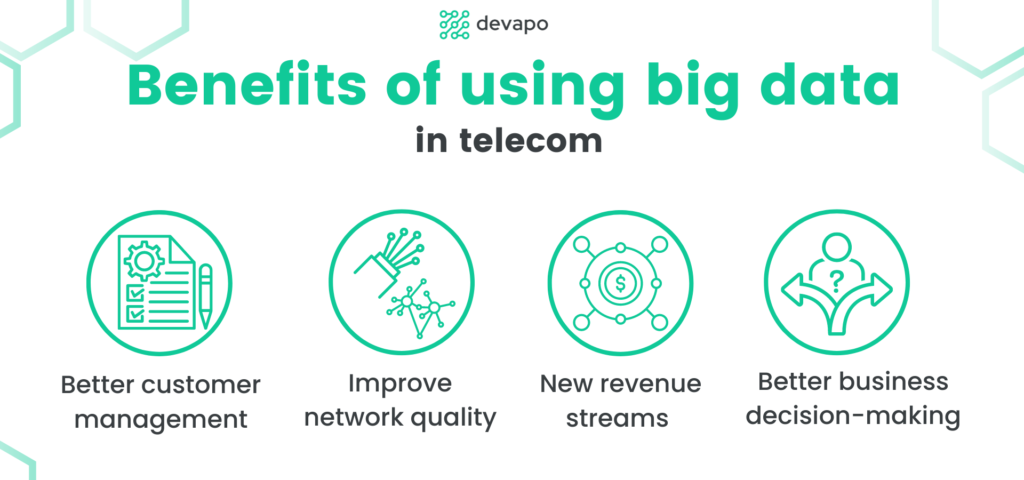- Mariusz Kujawski
- Read in 6 min.
I once heard that data monetization is a mission, an ambition and a responsibility. In the telecommunications industry, where the flow of data is enormous, this phrase resonates even more strongly. But in my experience, many communications service providers (CSPs) are struggling to handle data optimally. Telecoms not only have to process, store and gain insights from disparate and massive amounts of data, but also maintain its highest quality. Otherwise, data will contribute to misunderstanding instead of profit.
The purpose of this article is to explain how to deal with massive telco data, that it can be monetized. As a data engineer and enthusiast, I’ll give you a few tips on how to do so.
Big Data Analytics in telecom industry – Use Cases
First things first. You need to be aware of where your telco data are coming from and what you can get out of it. Most of them are probably used for OSS and BSS and help make data-driven decisions. Big data analytics can improve profitability, but only if you can recognize what each piece of information is responsible for. Telecoms use both primary and secondary data from different sources and for various purposes, therefore often deal with silos that are hard to understand. Leverage big data analytics and get actionable insights in order to obtain economically quantifiable benefits. Here are some examples of the monetizing data to boost efficiency and profitability in telecom industry.
Better quality of service, thanks to OSS/BSS data analytics and network monitoring
With a unified data model, you can better manage your product catalog and improve order management. Make it easier to capture, approve and launch new orders for wholesale, especially if you operate with multiple ordering systems.
Another use of data in efficient customer service may concern network monitoring. IoT devices collect data and respond intelligently to events. Combined with Machine learning (ML), you can easily draw conclusions about a network’s health. This enables real-time monitoring and management. Among other things, it will help you detect problems with fiber or wireless networks more efficiently; better allocate the resources needed to maintain their quality; or manage trouble tickets faster. This translates into improved network performance and reliability, which provides end customers with a better quality of service.
Telco data for successful business and investment activities
Companies in the telecommunications market use both their own databases and external information for this purpose. Knowing (for example) a competitor’s reach and some key data about their operations, then comparing it with information about your own infrastructure, gives you a better, broad view of your expansion plans. A variety of data allows you to make more informed, data-driven decisions about your business. They can be useful for wholesale fiber provisioning, controlling expansion costs, or network maintenance.
New revenue streams – traffic analysis and demand forecasting
Application data, or network data containing usage records such as CDRs, allow analysis of online but also offline traffic. By understanding such data, you can monetize it. Some examples include selling aggregated and anonymized data or in the form of a comprehensive report with data visualization. Such information can be used by all kinds of industries looking to implement IoT, Smart City or Big Data services.

These were only a few examples of what capabilities you can have as a data-driven organization. But to get such results you have to ensure mature data management. Let’s move on, I will explain to you what you should look after to become a data-driven telecom.
How to deal with massive telco data? Best practices
In order to ensure the reliability and accuracy of the telco data, it is important to implement best practices for data maintenance. This includes regularly updating and cleaning the data, as well as implementing robust security measures to protect sensitive information. But let’s get through some key aspects. To become a data-driven telecommunications company, you should take the following steps:
Data Collection
Identify all data sources you use. The collection of data generated by your network, customer interactions, and external data should be done in a centralized and organized manner. Telecoms are dealing with data heterogeneity, but having a consistent system that organizes all incoming data will make it easier to manage them later.
Data Storage
Ensure the proper storage of your data, with appropriate security measures in place to protect sensitive information. This may include encryption, access control (column and row level security, data masking), and regular backups to protect against data loss. You also need to decide what types of databases and storage systems you want to keep them.
- Relational databases: store structured data and use SQL for querying and manipulating the data.
- NoSQL databases: store unstructured or semi-structured data and can handle large volumes of data with high scalability and availability.
- Cloud storage: data is stored on remote servers accessed over the internet, providing scalable storage capacity and off-site backup.
- Data lakes: are usually used to store structured, semi-structured, or unstructured data and are used as a source for Big Data analytics initiatives.
- Data warehouses: designed for fast querying and analysis of large amounts of data and support large-scale data mining and reporting.
Data compliance
Make sure your data is compliant. Don’t skip thorough inspection required for data regulations, otherwise you may meet with serious consequences.
Data governance
Teams leveraging a power of data must use the same nomenclatures for consistency. Otherwise, interpretations of the same data may differ, making data-driven decisions unnecessarily difficult.
Data and systems integration
Make sure all relevant data and systems are integrated and accessible to decision-making teams. You can use data integration tools for this purpose. Keep in mind that in addition to integrating key OSS and BSS systems, it’s also a wise to do this with other business systems used in your company, such as CRM.
Data quality control
Remember to regularly review and evaluate the effectiveness of your data. You can make sure if your information is complete, accurate, consistent and free from errors through various methods. It includes data validation, data enrichment, data cleaning, data reconciliation and data standardization.
Data Analysis
Analyze raw enterprise data that were collected to gain insights and identify trends, patterns, and opportunities for improvement. This can be done using various tools and techniques such as data visualization, machine learning, and predictive analytics.
By following these steps, telecommunications companies can become data-driven organizations. Be better equipped to make informed decisions, improve your operations, customer experience, and achieve a competitive advantage in the market.
How can Devapo help?
As a technology company, we understand the importance of utilizing data to drive business decisions. That’s why we offer a comprehensive solution to help our telecom customers become data-driven organization. Our solution includes a robust data management system that collects, stores, and analyzes vast amounts of data from various sources, including network operations, customer behavior, and financial performance. This system allows for real-time data analysis and visualization, providing valuable insights into key business metrics.
We will ensure uninterrupted operation of your data maintenance and analysis platform. We are able to connect new data sources to be immediately available to your analysts, regardless of space (Cloud, On-premises, Hybrid). With Devapo’s help, your data collection and processing network will always be at peak performance.
We supports our customer in transformation from the on-premise to the Cloud environment. We recommend how to move from IaaS (Infrastructure as a Service) to SaaS (Software as a Service) approach to help reduce cost of data platform, and develop a flexible and a cost-effective solution. Also, we advise how to build Cloud native and Cloud agnostic solutions depending on clients needs and a company vision.
Summary
Data-driven in the telecommunications industry means using data to detailed data monetization, build strategy, inform, and make better decisions. This includes analyzing data to gain insights into customer behavior, network performance and other key areas, to use these insights to manage such activities as product development, network planning or optimization and more.
The goal is to boost your telecommunication company’s performance, increase efficiency and competitiveness and move into a direction where the company will be able to make data-driven decisions not only based on the current analysis but also forecasting and prediction thanks to machine learning utilization.
Leverage the power of data to drive your business success
We provide solutions for telecom industry









